Infrastructure and technology development
CCFS links three internationally recognised concentrations of analytical geochemistry infrastructure: GEMOC’s Geochemical Analysis Unit (Macquarie University) and the associated Computing Cluster, the Centre for Microscopy, Characterisation and Analysis (UWA/Curtin) and the John de Laeter Centre of Mass Spectrometry. All are nodes for the NCRIS AuScope and Characterisation Capabilities, and have complementary instrumentation and laboratories. In addition, Curtin and UWA share a leading facility for paleomagnetic studies.
Facilities:
CCFS/GEMOC INFRASTRUCTURE, LABORATORIES AND INSTRUMENTATION
CMCA TECHNOLOGY DEVELOPMENT AND INSTRUMENTATION
WESTERN AUSTRALIA PALAEOMAGNETIC AND ROCK-MAGNETIC FACILITY
CCFS/GEMOC INFRASTRUCTURE, LABORATORIES AND INSTRUMENTATION
The analytical instrumentation and support facilities of the Macquarie University Geochemical Analysis Unit (GAU) represent a state-of-the-art geochemical facility built up as part of GEMOC.
The GAU contains:
- a Cameca SX-100 electron microprobe
- a Zeiss EVO MA15 Scanning electron microscope
- four Agilent ICPMS (industry collaboration; two 7500cs; two 7700cx)
- a custom-built UV laser microprobe, usable on the Agilent ICPMS
- three New Wave laser microprobes (one 266 nm, two 213 nm, each fitted with large format sample cells) for the MC-ICPMS and ICPMS laboratories (industry collaboration)
- a Nu Plasma multi-collector ICPMS
- a Nu Plasma high resolution multi-collector ICPMS
- a Thermo Finnigan Triton TIMS
- a Spectro XLAB2000 energy-dispersive XRF with rocker-furnace sample preparation equipment
- a LECO RC412 H2O-CO2 analyser
- an Ortec Alpha Particle counter
- a New Wave MicroMill micro-sampling apparatus
- a ThermoFisher iN10 FTIR microscope
- selFrag electrostatic rock disaggregation facility
- clean labs and sampling facilities provide infrastructure for ICPMS, XRF and isotopic analyses of small and/or low-level samples
- Experimental petrology laboratories include four piston-cylinder presses (pressures to 4 GPa), hydrothermal apparatus, controlled atmosphere furnaces, Griggs apparatus and a multi-anvil apparatus for pressures to 27 GPa.
THE GEMOC FACILITY FOR INTEGRATED MICROANALYSIS (FIM) AND MICRO-GIS DEVELOPMENT
Within CCFS, GEMOC is continuing to develop a unique, world-class geochemical facility, based on in situ imaging and microanalysis of trace elements and isotopic ratios in minerals, rocks and fluids. The Facility for Integrated Microanalysis now consists of four different types of analytical instrument, linked by a single sample positioning and referencing system to combine spot analysis with images of spatial variations in composition (“micro-GIS”). All instruments in the FIM have been operating since mid-1999. Major instruments were replaced or upgraded in 2002-2004 through the $5.125 million DEST Infrastructure grant awarded to Macquarie University with the Universities of Newcastle, Sydney, Western Sydney and Wollongong as partners. In late 2009 GEMOC was awarded an ARC LIEF grant to integrate the two existing multi-collector inductively-coupled-plasma mass spectrometers (MC-ICPMS) with 3 new instruments: a femtosecond laser-ablation microprobe (fs-LAM); a high-sensitivity magnetic-sector ICPMS; a quadrupole ICPMS. The quadrupole ICP-MS was purchased and installed in 2010; a Photon Machines femtosecond laser system and a Nu Attom ICP-MS are on order and will be installed in 2012.
PROGRESS IN 2011
1. Facility for Integrated Microanalysis
a. Electron Microscope; Electron Microprobe: The Zeiss EVO MA15 SEM carried the electron imaging workload, providing high-resolution BSE and CL images for TerraneChron® (http://www.gemoc.mq.edu.au/TerraneChron.html) and all other research projects, including diamonds and diamondites, and PGM in chromitites. The SX100 serviced the demands for quantitative mineral analyses and X-ray composition maps for all projects including analysis of perovskite in kimberlites; analysis of base metal sulfides and platinum group minerals; minor and trace element analysis of metals.
b. Laser-ablation ICPMS microprobe (LAM): Output from the LAM laboratory in 2011 increased from 2010 and the facility was used by thirteen Macquarie PhD thesis projects, twelve international visitors, four Honours students, and several in-house funded research projects and industry collaborations. Projects included the analysis of trace elements in the minerals of mantle-derived rocks, in sulfide minerals and a range of unusual matrices. As in recent years more than 7000 U-Pb analyses of zircons were carried out, related to projects (including TerraneChron® applications: http://www.gemoc.mq.edu.au/TerraneChron.html from Australia (NSW, WA, SA), New Zealand, France, Laos, Serbia, Papua New Guinea, Turkey, Zambia, Mongolia, Russia, Germany, Mauritania and Chile. The LAM laboratory also routinely provides data for projects related to mineral exploration (diamonds, base metals, Au) as a value-added service to industry.
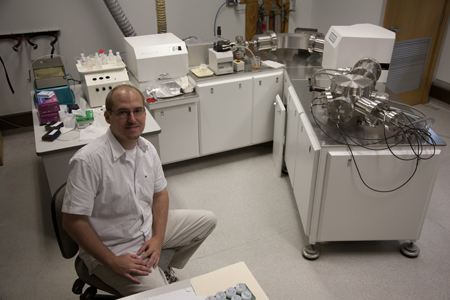
Marek Locmelis using the MC-ICPMS.
c. MC-ICPMS: The continued increase of TerraneChron® activities (see http://www.gemoc.mq.edu.au/TerraneChron.html) involving the measurement of Hf isotopes, coupled with the growing demand for in situ analysis of other radiogenic isotope systems (e.g. Re-Os analysis in sulfide and PGM; Nd-Sm and Rb–Sr in perovskite) and stable isotope analysis, created severe competition for instrument time on the LAM MC-ICPMS.
Major applications during 2011 using in situ techniques continued to centre on the high-precision analysis of Hf in zircons to trace lithosphere evolution and magma-mixing histories in granitic rocks, and Re-Os dating of single grains of Fe-Ni sulfides and alloys in mantle-derived rocks. In situ Hf isotopes were measured in zircons from Australia, New Zealand, France, Laos, Serbia, Papua New Guinea, Turkey, Zambia, Mongolia, Russia, Germany, Mauritania and Chile. We carried out Re-Os studies on xenoliths from eastern China, Siberia, Mongolia, France, Spain, the USA and South Africa. Sr and Nd isotopes were measured in situ in kimberlitic perovskites from South Africa.
The Laser-ablation ICPMS microprobe.
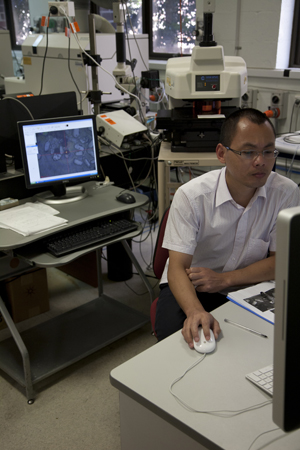
d. Laboratory development: The clean-room facility established in 2004 continued to be used primarily for isotope separations for analysis on the Triton TIMS and Nu Plasma MC-ICPMS. Routine procedures have been established for Rb-Sr, Nd-Sm, Lu-Hf and Pb isotopes, as well as U-series methods (U, Th and Ra).
e. Software: GLITTER (GEMOC Laser ICPMS Total Trace Element Reduction) software is our on-line interactive program for quantitative trace element and isotopic analysis and features dynamically linked graphics and analysis tables. This package provides the first real-time interactive data reduction for LAM-ICPMS analysis, allowing inspection and evaluation of each result before the next analysis spot is chosen. Its capabilities include the on-line reduction of U-Pb data. The use of GLITTER has greatly increased both the flexibility of analysis and the productivity of the laboratory. Sales are handled by Access MQ and GEMOC provides customer service and technical backup. During 2011 a further 15 full licences of GLITTER were sold bringing the total number in use to 186 worldwide, in forensics and materials science, as well as earth science applications. Dr Will Powell continued in his role in GLITTER technical support and software development through 2011. The current GLITTER release is version 4.4.3 and is currently available without charge to existing customers and accompanies all new orders (http://www.glitter-gemoc.com/).
2. Energy dispersive XRF
A Spectro XLAB2000 energy-dispersive X-ray spectrometer, installed in November 2000 in a joint venture with Tasman Resources, provided high-quality major- and trace-element data through 2011.
3. Whole-rock solution analysis
An Agilent 7500cs ICPMS produces trace-element analyses of dissolved rock samples for the projects of GEMOC researchers and students and external users, supplementing the data from the XRF.
Further advances were made in the analysis of ‘non-traditional’ stable isotopes and included the development of separation techniques and analytical protocols for Mg isotopes in garnet and the refinement of methods for the separation and analysis of Li isotopes in ultramafic rocks. The permanent availability of one of the Agilent 7500cs instruments for solution analysis greatly benefited the development of the separation techniques.
4. Diamond preparation and analysis
The GEMOC laser-cutting system (donated by Argyle diamonds in 2008), was used during 2011 to cut thin plates of single diamond crystals as part of the on-going research into diamond genesis. The plates are used for detailed spatial analysis of trace elements, isotopic ratios and the abundance and aggregation state of nitrogen. The nitrogen measurements are made using the ThermoFisher iN10FTIR microscope, which allows the spatial mapping of whole diamond plates at high resolution with very short acquisition times. The DiaMap software for creating these maps was developed by Dan Howell and Craig Smith.
5. selFrag – a new approach to sample preparation
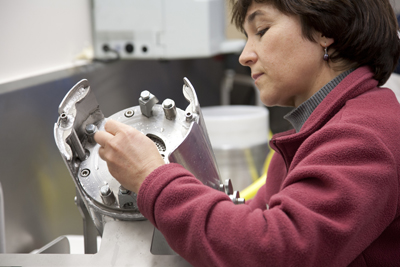
Elena Belousova using the SelFrag
The first selFrag instrument in Australia was installed in GEMOC in May 2010 and was used extensively through 2011 for mineral liberation. This instrument uses high-powered electrical pulses to disaggregate rocks and other materials along the grain boundaries. It removes the need to crush rocks for mineral separation, and provides a higher proportion of unbroken grains of trace minerals such as zircon. Since its installation the selFrag has been used for a range of applications including zircon separation, the analysis of grain size and shape in complex rocks, and the liberation of trace minerals from a range of mantle-derived and crustal rocks.
6. Computer cluster
A 64-core ARC-funded computer cluster (Enki) came online in 2010, with the capability to run massively parallel high-resolution geodynamics simulations in 3D at a global scale. Further funding in 2011 was used to expand the cluster into a 160-core machine. Updated rack storage and power supplies have been completed, and the upgraded machine is currently in full operation.
The cluster is running some of the most cutting-edge simulation software packages, including CitcomS – enabling 3D spherical mantle simulations, and Underworld – a lithosphere and mantle deformation computational framework designed for massively parallel simulations. It has supported four Honours student projects, as well as two ongoing PhD projects, and underpins at least four successful ARC Discovery projects.
Internal capacity in this kind of computing is necessary as externally available clusters (e.g. At AC3/Intersect, or at NCI) are specifically for “production” runs only – not for research and development of experimental codes. However, many of these codes have absolute minimum resolution requirements which can only be met by a large cluster. For example, CitcomS requires at least 12 nodes to run, or 96 for a fully resolved simulation, which is often necessary for the testing of new modules. This cannot be done on a desktop machine, and since testing is not allowed on the public machines, the in-house cluster is essential to the development of the next generation of simulation tools.
CMCA TECHNOLOGY DEVELOPMENT AND INSTRUMENTATION
The University of Western Australia’s Centre for Microscopy, Characterisation and Analysis (CMCA) is a $40M core facility providing analytical solutions across a diverse array of scientific research. The world-class facilities and associated technical and academic expertise are the focus of micro-analytical and characterisation activities within Western Australia, while strong links and collaborations have earned the CMCA an excellent national and international reputation. The CMCA incorporates the Western Australian Centre for Microscopy, and is a node of the NCRIS Characterisation capabilities, the National Imaging Facility (NIF) and the Australian Microscopy and Microanalysis Research Facility (AMMRF). It is also associated with the NCRIS-funded Australian National Fabrication Facility (ANFF) and AuScope, which have made a substantial contribution to facilities run by CMCA.
CMCA capabilities:
- CAMECA IMS 1280 and CAMECA NanoSIMS 50 ion microprobes
- JEOL JXA 8530F electron microprobe, with Cathodoluminescence imaging (CL)
- Transmission Electron Microscopes (JEOL 3000F, 2100 and 2000FX), with EDS and energy-filtered EELS analysis capabilities
- Scanning electron microscopes (Zeiss 1555, 2 JEOL 6400, Philips XL30)
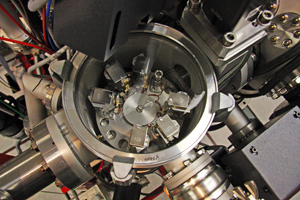
- X-ray powder diffraction (Panalytical Empyrean)
- NMR spectroscopy (2 Bruker Avance and 2 Varian spectrometers)
- Optical and confocal microscopy
- Micro-CT (to be installed 2012)
- Bioimaging, flow cytometry, cell sorting, and laser micro-dissection
- X-ray crystallography
- GC and HPLC mass spectrometry
- Biological sample cryo-preparation and ultramicrotomy
THE AMMRF FLAGSHIP ION PROBE FACILITY 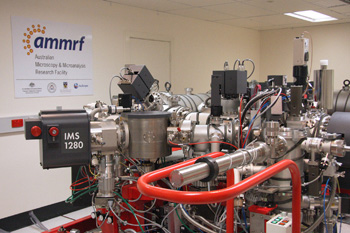
The CAMECA IMS 1280 and NanoSIMS 50 are flagship instruments of the Australian Microscopy and Microanalysis Research Facility (AMMRF). The AMMRF Flagship Ion Probe Facility offers state-of-the-art secondary ion mass spectrometry (SIMS) capabilities to the Australian and international research communities, allowing in situ, high-precision isotopic and elemental analyses, secondary ion imaging, and depth profiling on a wide range of samples.
The IMS 1280 large-geometry ion probe, installed in 2009, was co-funded by the University, the State Government of Western Australia, and the Federal Government’s Department of Innovation, Industry, Science and Research (DIISR) under the ‘Characterisation’ (AMMRF) and ‘Structure and Evolution of the Australian Continent’ (AuScope) capabilities of the National Collaborative Research Infrastructure Strategy (NCRIS). The NanoSIMS 50, installed in 2003, was funded through the Federal Government’s NCRIS-precursor, the Major National Research Facility scheme (NANO-MNRF).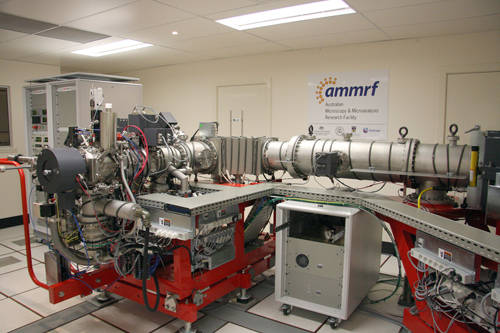
The instruments are managed by the Western Australia Ion Probe Management Committee, which also manages the two SHRIMP II ion probes located at Curtin University. Access to the Ion Probe Facility is subsidised for publicly-funded researchers within Australia via a merit-based competitive application scheme, where projects are assessed by a scientific committee of international experts.
The Ion Probe Facility is a key characterisation component within the ARC Centre of Excellence for Core to Crust Fluid Systems. To ensure the highest levels of quality and throughput, the CCFS has provided funding for a Research Associate position within the Ion Probe Facility, to facilitate direct scientific and technical interaction for all CCFS users and projects.
PROGRESS IN 2011
Standards development:
2011 has seen a continued progress in developing more modes of SIMS analysis. In addition to the standard analyses being performed in the IMS 1280 lab (including B, C, O, S, and U isotopic measurements) development has begun on H, Li, Mg, Si, Cl, Fe and Sr and Pb isotopic analysis. Most of these analyses are hampered by the availability of appropriate isotopic standards and thus a continued effort is underway to develop such standards for a variety of systems. Collaborative links have been forged with Geoscience Australia and the Geological Survey of Western Australia to obtain a supply of zircons that can be used for dating and as Hf-O-isotope standards. Sulfur isotopic systems are also becoming increasingly popular with users, due to the fact that the IMS 1280 can easily measure in situ δ33S and δ34S to better than 0.1 ‰ and δ36S to better than 0.2 ‰, and therefore determine Δ33S and Δ36S to identify mass-independent fractionation signatures. Due to the global scarcity of well-characterised sulfide standard materials, the Ion Probe Facility has sought to develop in-house standards, utilising collaborative links with Marco Fiorentini (CCFS), James Farquhar (The University of Maryland), Bos Wing (McGill University) and Sue Golding (University of Queensland). This has resulted in the successful development of S-isotope standards for pyrite, pyrrhotite and pentlandite. Similar development of more standards for sulfur, zircon, garnet, apatite and iron-oxide is underway.
Personnel:
Ion probe specialist Sten Littman left UWA to return to Germany at the end of 2011, and the CMCA is currently in the process of appointing his replacement. In addition, the position for the CCFS Technical Development project (Cameca ion microprobe development) was advertised in the second half of 2011, with the recruitment process set to conclude in early 2012. The Ion Probe Facility is managed by Matt Kilburn and John Cliff. Also in 2011, the CMCA recruited David Adams from the USGS to provide support to the newly-commissioned electron microprobe.
New electron microprobe:
In 2010, the CMCA installed a new state-of-the-art JEOL 8530F electron microprobe, equipped with five WDS spectrometers, a silicon drift detector and field-emission electron gun. This $1.6M instrument was funded through the 2009 ARC LIEF scheme with partners Curtin, Edith Cowan and Murdoch Universities, CSIRO and ALCOA, to provide the Western Australian earth science community with a cutting-edge platform. This instrument will be heavily utilised by WA-based CCFS researchers.
In addition to the instrument software, the electron microprobe is also equipped with ProbeSoftware Inc.’s Probe for EPMA microanalysis software, increasing the capability of the microanalyses that are performed particularly for the earth/geosciences. The electron microprobe is also equipped with an Ocean Optics spectroscopic cathodoluminescence system allowing simultaneous analysis of characteristic x-ray and cathodoluminescence maps of materials.
Research highlights:
The continued development of isotopic analysis using the NanoSIMS 50 resulted in three publications during 2011, including one in Nature Geoscience that sparked a media-frenzy around the world. The paper revealed evidence of the fossilised remains of microbial cells in a 3.45 Ga sandstone from the Pilbara region of Western Australia, using data from both the NanoSIMS and IMS 1280. Media highlights included being the most-read article on the New York Times website on the day of publication, August’s entry in the BBC’s top science stories of 2011 alongside the Japanese tsunami and the detection of the Higgs-boson, and featuring as a News Brief in New Scientist (see here and CCFS Publication #86).
JOHN DE LAETER CENTRE
The John de Laeter Centre houses a suite of mass spectrometry instruments and is a collaborative research venture involving Curtin University, the University of Western Australia, CSIRO and the Geological Survey of WA. It hosts over $25M in infrastructure in key facilities supporting research in: geosciences (geochronology, thermochronology and isotope studies); environmental science and global change; isotope metrology; forensic sciences; economic geology (minerals and petroleum); marine sciences; nuclear sciences. The components are organised into nine major facilities.
The Advanced Ultra-Clean Environment (ACE) Facility: This consists of a ~400m2 class 1000 containment space that houses four class 10 ultra-clean laboratories, a class 10 reagent preparation laboratory and a −18°C class 10 cold clean laboratory, located at Curtin University. The extremely low ultimate particle counts are achieved with successive ‘spaces within spaces’ and HEPA (99.999% high efficiency particle arresting) filtration at each stage.
Inductively-Coupled Plasma Mass Spectrometry (ICPMS) Facility: This facility is located at UWA and consists of:
- TJA (VG/Fisons) PlasmaQuad 3 Quadrupole ICP-MS. The system has a high sensitivity interface to facilitate ultra-low detection limits.
- TJA (VG/Fisons) Laserlab high resolution 266nm (Frequency quadrupled Nd-YAG) laser. The laser system is adapted with a high-resolution interface to facilitate the ablation of craters down to 10μ in diameter.
- GBC Optimas 8000 Time of Flight ICP-MS
- Leco Renaissance Time of Flight ICP-MS
- A wide range of chromatographic and thermal dissociation interfacing is also available.
Argon Isotope Facility: This is located at Curtin and is equipped with a MAP 215-50 mass spectrometer with a low-blank automated extraction system coupled with a NewWave Nd-YAG dual IR (1064 nm) and UV (216 nm) laser, an electron multiplier detector and Niers source. Laser analysis allows for high spatial resolution up to 10μm beam size for UV laser and 300μm for IR laser. Larger sample sizes (>8-10 mg) are accommodated by an automated Pond-Engineering low-blank furnace. The extraction line has a Nitrogen cryocooler trap and three GP10 getters that allow gas purification. An Argus VI Mass Spectrometer and a Photon Machines Laser have been ordered for the JdL facility.
A joint ANU-John de Laeter Centre for Mass Spectrometry (JdL) Argon Facility has been established following a successful ARC bid. A total of ~$988,200 will be expended with the ARC contribution being $420,000. A management committee comprising two Facility Directors (Dr Marnie Forster, RSES, and Dr Fred Jourdan, JdL), Director JdL (Professor Brent McInnes), Mr Michael Avent (School Manager, RSES) and Professor Gordon Lister (RSES and named Project Manager and Chief Investigator on the ARC grant) has been set up and approved by all Collaborating and Partner Organisations.
We have been granted formal approval to purchase two Argus VI Mass Spectrometers for the Joint Argon Facility at ANU and JdL at Curtin University at an approximate cost of $A630,000. These machines have been ordered, and will arrive in March 2012. The ancillary items required for the facility are now in the process of being purchased, and/or constructed. A Photon Machines Laser has been ordered for the JdL facility. A decision was made to purchase a commercially available cryopump and to build our own cryo-cooler using this unit, and an assembly built at RSES, allowing for considerable saving. The cryopumps will arrive in February 2012 at which point the design will be tested. The extraction lines have been designed, with 3D drawings, and their construction will shortly commence. A step-heating furnace design is under consideration. Different options for valves, etc. are still under consideration. The mass spectrometers at both RSES and Curtin University will be located in special purpose, newly renovated rooms, with the costs of these extensive renovations borne by RSES and JdL. These include air conditioning to allow ±1°C temperature control with set humidity, vibration tests, anti-vibration mats and legs, electrical updating, internet and ethernet connectivity, updating lighting, repainting and rebuilding ceilings and walls.
Organic Geochemistry Facility: This facility is located within Applied Chemistry at Curtin and the instruments used for biomarker, petroleum and water studies include:
- GCMS (Gas Chromatograph Mass Spectrometer)
- GC-HRMS-MS (Gas Chromatograph-High Resolution Mass Spectrometer)
- Py-GC-MS (Pyrolysis-Gas Chromatograph-Mass Spectrometer)
- LCTOFMS (Liquid Chromatograph-Time of Flight-Mass Spectrometer)
- LC-MS-MS (Liquid Chromatography-Mass Spectrometry-Mass Spectrometer)
- HPSEC-DAD (High Performance Size Exclusion Chromatograph-Diode-Array Detection)
- GCIRMS (Gas Chromatograph-Isotope Ratio-Mass Spectrometer)
- TD-GC-IRMS (Thermal Desorption-Gas Chromatograph-Isotope Ratio-Mass Spectrometer)
- EA-IRMS (Elemental Analysis-Isotope Ratio-Mass Spectrometer)
Sensitive High Resolution Ion Micro Probe (SHRIMP): The facility at Curtin has two automated SHRIMP II ion microprobes capable of 24-hour operation, together with a preparation laboratory. The equipment allows in situ isotopic analysis of chemically complex materials with a spatial resolution of 5-20 microns. The main application of the SHRIMP instruments at Curtin is for U-Th-Pb geochronology of mineral samples. Zircon and other U-bearing minerals, including monazite, xenotime, titanite, allanite, rutile, apatite, badelleyite, cassiterite, perovskite and uraninite are the main minerals studied, where multiple growth zones commonly require high spatial resolution analyses.
Stable Isotope Ratio Mass Spectrometry (SIRMS) Facility: The West Australian Biogeochemistry Centre (WABC) at UWA is associated with the WA John de Laeter Centre of Mass Spectrometry and provides a range of analytical and interpretive services to researchers both within UWA and in the broader scientific community. The WABC currently operates three isotopic ratio mass spectrometers (IRMS) plus a considerable range of further analytical instrumentation (GC, HPLC, CE autoanalyser) routinely used in biogeochemical studies. A fourth IRMS (especially for small-sample δ13C and δ18O and carbonate analysis) is now being commissioned. Our IRMS are coupled with a variety of sample preparation modules to facilitate analysis of a broad range of sample matrices. Consequently, a wide range of applications of stable isotopes is supported by this facility.
Thermal Ionization Mass Spectrometry (TIMS) Facility: The TIMS facility at Curtin incorporates a Thermo Finnegan Triton™ and a VG 354 multicollector mass spectrometer. The Triton is equipped with a 21-sample turret and 9 faraday cups, enabling a precision of 0.001% on isotopic ratios. As well as geological applications within the broad field of isotope geochronology (Re/Os, U/ Pb, Pb/Pb, Sm/Nd, Rb/Sr) the TIMS instruments can be applied to a variety of subject areas involving isotope fingerprinting, such as mantle geodynamics, forensics and the environmental impact of human activities. The TIMS instruments are also widely used in chemical metrology for the calibration of isotopic standards, and the calculation of isotopic abundances and atomic weights.
(U-Th)/He Facility: The laboratory at Curtin hosts the prototype of the Alphachron™ automated helium microanalysis instrument marketed by Australian Scientific Instruments in Canberra and will house a new Alphachron™ machine in 2012. (U-Th)/He thermochronology involves the measurement of the amount of 4He in minerals generated by the radioactive decay of U and Th. Helium is an inert gas that is quantitatively retained by minerals at low temperature, but is gradually lost from the mineral lattice by diffusion at elevated temperatures. Some minerals are more retentive to helium than others (e.g. zircon = 200°C vs apatite = 75°C), a unique characteristic that, when integrated with other techniques such as U-Th-Pb and Ar-Ar dating, can be used to produce complete time-temperature histories through a temperature interval from 900°C to 20°C. The CSIRO/JDLC (U-Th)/He Facility provides thermal-history analysis of metallogenic and petroleum systems by integrating several age-dating capabilities along with 4D thermal modeling. The Facility is also involved in fundamental collaborative research in the fields of orogenic tectonics, volcanology and quantitative geomorphology.
K-Ar Geochronology Facility: The K-Ar facility utilises the following instrumentation and techniques:
- VG3600 noble gas mass spectrometer
- Heine double vacuum resistance furnace
- Clay mineral separation laboratory utilising cryogenic disaggregation of rock samples
- XRD, SEM, TEM, particle size analysis for clay characterisation
- Vacuum encapsulation station for Ar-Ar dating of ultrafine samples
- Clays – illite: Dating the timing of diagenetic and deformation events
- Fault gouge dating (illite) – earthquake and hazard assessment
WESTERN AUSTRALIA PALAEOMAGNETIC AND ROCK-MAGNETIC FACILITY
The Western Australia Palaeomagnetic and Rock-magnetic Facility was established at the University of Western Australia by CCFS CI Z.X. Li in 1990, funded by a UWA start-up grant to the late Professor Chris Powell. It was subsequently upgraded through an ARC Large Instrument Grant in 1993 to purchase a then state-of-the-art 2G Enterprises AC-SQUID cryogenic magnetometer and ancillary demagnetisation and rock magnetic instruments. It was upgraded again in 2006 into a regional facility, jointly operated by Curtin University, UWA and the Geological Survey of WA through an ARC LIEF grant with a 4k DC SQUID system plus a Variable Field Translation Balance (VFTB). A MFK-1FB kappabridge was installed in 2011.
The facility is one of the three similar laboratories in Australia, with major instruments including:
- 2G cryogenic magnetometer upgraded (LE0668377) to a 4K DC SQUID system
- MMTD80 (one) and MMTD18 (two) thermodemagnetisers
- Variable Field Translation Balance (VFTB)
- MFK-1FB kappabridge
- Bartington susceptibility meter MS2 with MS2W furnace
A wide range of research topics have been investigated using the facility, including reconstructing the configuration and drifting history of continents all over the world from the Precambrian to the present, analysing regional and local structures and deformation histories, dating sedimentary rocks and thermal/chemical (e.g. mineralisation) events, orienting rock cores from drill-holes, tracing ancient latitude changes, palaeoclimates, and recent environmental pollution.
Program 1: Regional and Global Tectonic Studies
Palaeomagnetism and rock magnetism are employed to study tectonic problems ranging from global to microscopic scales. The WA research group plays a leading role in a worldwide effort to establish the configuration and evolution of supercontinents Pangaea, Gondwanaland, Rodinia, and pre-Rodinia supercontinents.
Program 2: Ore genesis studies and geophysical exploration
We carried out a major research program on the timing and genesis of the giant iron ore deposits in the Pilbara region, and obtained a systematic set of petrophysical parameters for rock units in the region that enables more reliable interpretations of geophysical survey results (gravity and magnetic).
Program 3: Magnetic signatures in sediments as markers of environmental change
Sediments in suitable environments can incorporate a large number of environmental proxies. A major strength of environmental-magnetism analyses, such as magnetic susceptibility and saturated isothermal magnetism, is that they provide a rapid and non-destructive method of obtaining information on changes in palaeoclimate and environment of sedimentation. In addition, rock magnetism can be used for monitoring and tracing industrial pollution.
Program 4: Magnetostratigraphy
We are conducting major research programs in the Canning Basin and in East Timor, both linked to petroleum resources.

 ARC Centre of Excellence for Core to Crust Fluid Systems
ARC Centre of Excellence for Core to Crust Fluid Systems